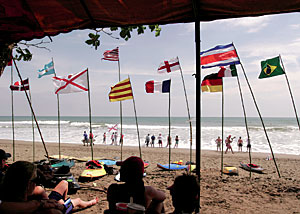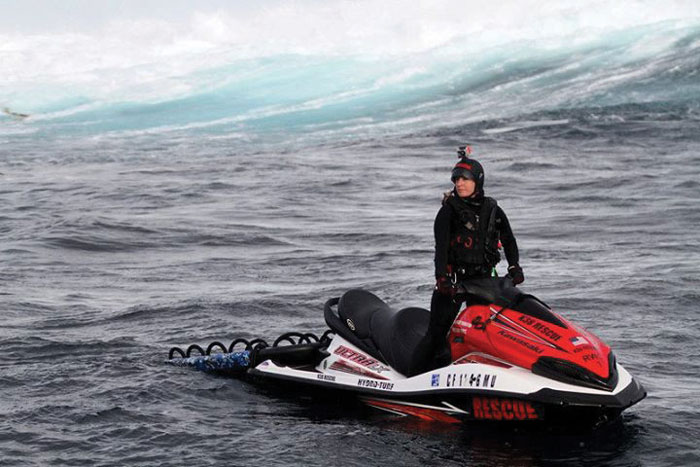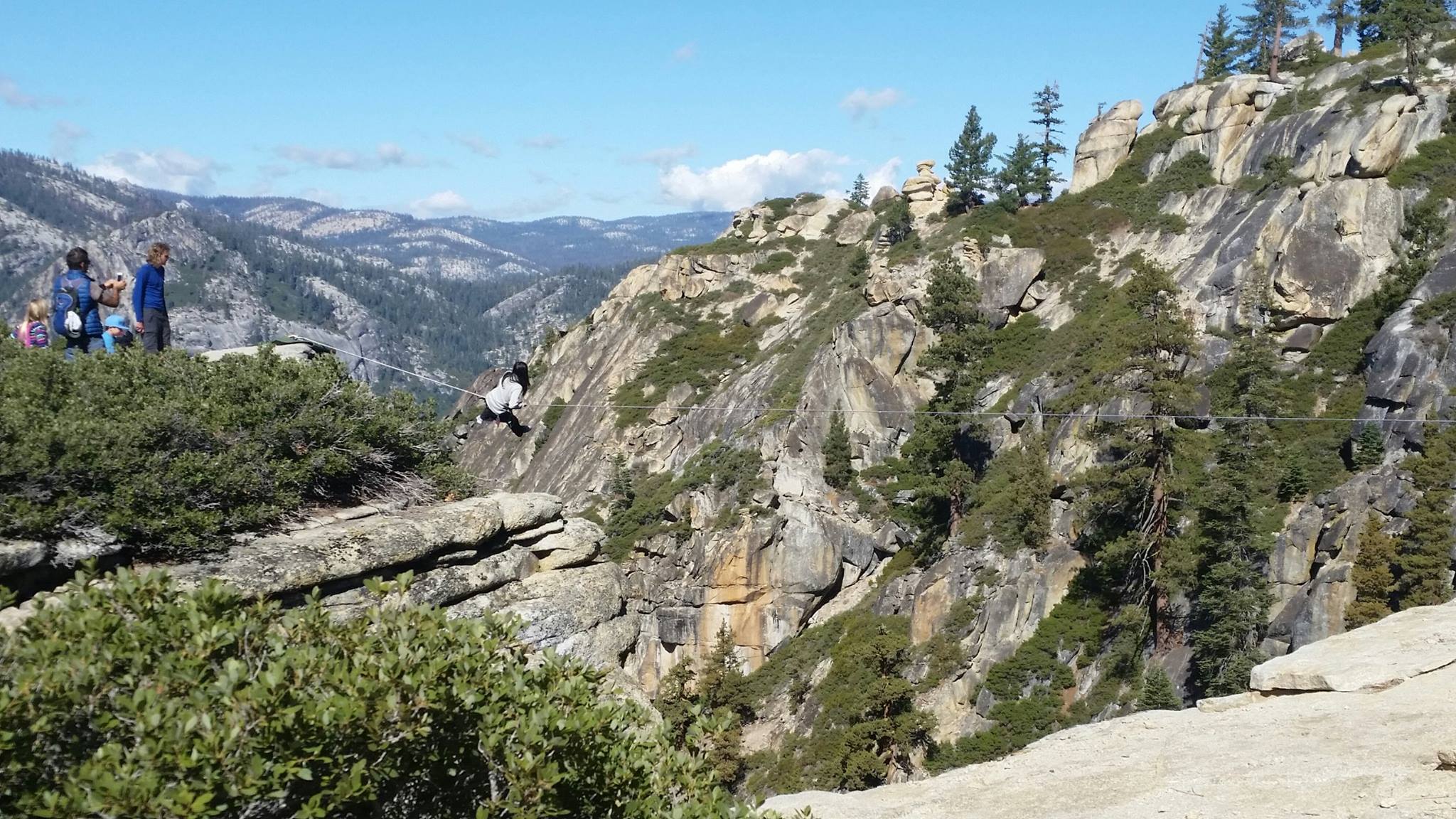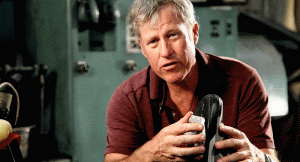- Tahoe’s Nevada Beach Tops the List of Hard-to-Book Campgrounds - 07/17/2024
- Cannabis Watershed Protection Program Cleans Up Illegal Grow Sites - 07/10/2024
- French Fire - 07/05/2024
US West Team Nor Cal surfers shine in Costa Rica
Story by Melissa Stevens • Photos by Jono Stevens
 The 2005 World Surf Kayaking Championships were held in Costa Rica in late October. If you missed the highlights on ESPN, you’re not alone. There were plenty of high moments in this biannual international good vibes get-together and surf competition. And wave riders from Northern California got more than their share.
The 2005 World Surf Kayaking Championships were held in Costa Rica in late October. If you missed the highlights on ESPN, you’re not alone. There were plenty of high moments in this biannual international good vibes get-together and surf competition. And wave riders from Northern California got more than their share.
Approximately 150 men and women from 16 countries shredded the warm Costa Rican surf for nine days, competing in both individual and team events. Wave riders came from all corners of the globe, including Japan, Scotland, Ireland, Brazil and Spain. The USA was well represented by two teams, US East and US West. Members of the US West Team, predominately from California and in particular the Santa Cruz area, were on a mission to snatch the world title away from the Irish, who won the last worlds in 2003.
The contest was held at a break near the town of Esterillos Oeste, about 20 minutes south of Jaco, a fast-growing surf town on the central Pacific Coast of Costa Rica. With a host of great sponsors, a team of professional surf judges, and a state-of-the-art timing system, the little beach was transformed into an Olympic-style contest site. The locals were very welcoming, observing the colorful gringos and their high-tech gear with mild curiosity. The children of the community even made flags for each country competing. After a great opening ceremony in Jaco and a thorough introduction to the Pura Vida (the “pure life,” the Tico anthem), the competitors were ready to slice up some waves.
Surf Kayaking Basics
Although not a new sport (history’s first wave riders rode in canoes or kayaks), surf kayaking remains low on the commercial-hype totem pole, which sits just fine with most of its low-key, eclectic, Pura Vida-guided athletes. In recent years, with the advent of edgier, shorter boat designs, surf kayakers have been able to reach new levels of dynamism. The best derriere surfers (to preemptively cast a lighter spin on the less flattering moniker, “butt surfers”) – many of whom are also accomplished board surfers, – are blending moves from whitewater kayaking and surfing to create some unique, sport-specific wave artistry.
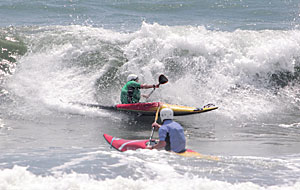 In competition, there are two boat categories: International Class (IC) and an Open Class (also referred to as High Performance, or HP). Boats in the IC category must be three meters or longer, and no fins are allowed. These are usually rounded hull boats with more traditional designs. For the Open category, paddlers may choose any style of decked boat (round or flat bottom, fins or no fins, short or long). Though most of these boats are shorter and flatter, with fins.
In competition, there are two boat categories: International Class (IC) and an Open Class (also referred to as High Performance, or HP). Boats in the IC category must be three meters or longer, and no fins are allowed. These are usually rounded hull boats with more traditional designs. For the Open category, paddlers may choose any style of decked boat (round or flat bottom, fins or no fins, short or long). Though most of these boats are shorter and flatter, with fins.
Contestants surf in heats of four for 20 minutes, and their score is based on total points for their three best rides. Judges use the following criteria to keep score: wave selection (the better the wave, the better the score), length of ride (longer is better), dynamic (yet controlled) moves on the critical part of the wave (the green section adjacent to the pile), and overall style. So the idea is to get the best waves, have the longest rides, and show your skill and control throughout. The top two finishers in each heat advance to the next round, until only four remain.
Getting Wet
The first two days of the contest were filled with intermittent downpours sent from the hurricane-churned Atlantic. But that did little to dampen spirits, or the waves that came forth from the mighty Pacific. Although they varied greatly with the tide, there were rideable waves throughout the contest. The Individual event took up the first two days, followed by the Team Event. The contest wrapped up with the finals for both. There were eight full teams, and also a “Rest of the World” team comprising paddlers from countries without full teams (16 paddlers plus 2-3 alternates). In all, nine teams competed for the title. Paddlers acquired points for their teams depending on their place in each heat. Everyone paddled twice, and at the end of two days, overall team points were tallied to determine the four teams advancing to the finals.
The competition was fierce. Each heat would swing teams ahead or behind. At the end of the first two days, US West, US East, Jersey, and Ireland came out on top. It was a crushing dissapointment for Northern Ireland, who had tied for fourth place with Ireland. To break the tie, judges counted the number of first place finishes, which were again tied, and then second place finishes. Ireland had one more second place finish and thus advanced to the finals.
As the final day of the team event began, US East quickly pulled into the lead, with Ireland close behind. Gaining more points with each heat, US West eventually pulled into a three-way tie for second, then a two-way tie for second. The competition between teams was tight throughout the entire day, even more so when the waves picked up with the incoming tide. With each heat score announced, the four teams continued to swap for first place.
Paddlers were ripping up set waves and throwing themselves into end moves. In one of the last heats of the contest, US West team member Dave Johnston, a former World Champion, caught the ride of a lifetime. Dropping down the face and taking control of his ride, he cleanly executed two roundhouse cutbacks and, using the pocket’s energy, came screaming down the line with a wall of whitewater behind him. As the wave began its final pitch and throw onto the sand, he shot up, in a lip-slashing aerial maneuver.
The energy level on the beach exploded as every person who could appreciate his masterful skills burst into shouts and applause. The applause turned to frenzied chaos when a swarm of viscious bees descended upon the crowd, sending spectators scattering in all directions. The judges were forced to hunker down and continue as best they could to judge the final heat. It was not the sort of finale buzz anyone expected!
After all was said and done, the awards ceremony was held at the resort and a huge international party ensued. A jubilant US West team celebrated their new title as World Champs, sharing laughs and memories of the last week with fellow competitors. Although they will tell you they came to surf, it’s hard to be sure that they didn’t just come to see their distant friends. The camaraderie among this group is strong, spanning borders, genders and generations.
Rumor has it that the next Worlds in 2007 will be held in Spain’s Basque Country. Surf kayakers, it seems, prefer to compete in exotic locations. And if ESPN can’t make it, too bad.

Surf Kayak Instruction
If you are interested in learning to surf kayak from some of the best in the world, Northern California is home to a number of instructors who are members of the US West Team and available for private lessons:
- Dennis Judson, Adventure Sports Unlimited: 831-458-3648
- Dave Johnston, Venture Quest: 831-427-2267
- Mark Pastik, Kayak Connection: 831-479-1121
- Dan Crandall, Current Adventures: 1-888-452-9254

